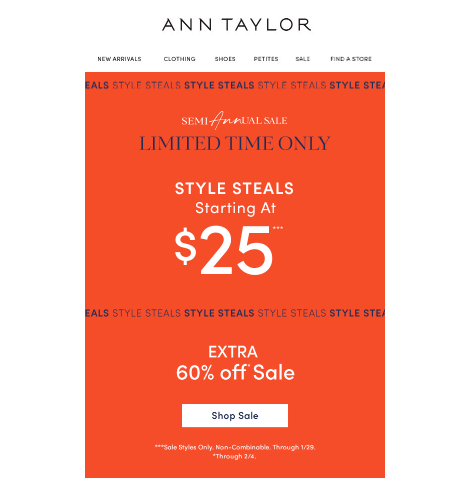
Email marketing has come a long way since the 1990s. We’ve evolved from text-only, generic messages to personalized, image and video-enabled content that targets individual consumers. Today’s email marketing technology makes it possible to develop streamlined, effective campaigns that genuinely engage subscribers.
Of course, email advertising techniques continue to progress. Staying on top of emerging trends in email marketing ensures brands continue to create relevant campaigns that resonate with their audiences and deliver results. In this article, we take a deep dive into new email strategies you can incorporate into your marketing toolbox.
Current email marketing trends
What’s the state of email marketing as we enter 2024? Here are a few email marketing stats to bring you up to speed:
- Companies consider email one of their top three effective marketing channels.
- Every dollar spent on email marketing yields $36 in return.
- Global email marketing revenues will reach $105 billion by 2026.
Over the past few decades, we’ve seen trends in email marketing change tremendously. Gone are the days of no-frills, block-text emails with a few links and no pictures.
Today’s marketing emails engage readers with hyperpersonalization, dynamic content, automation, and more. And technology continues to improve, providing marketers with a bevy of tools to capture customer attention.
Key email marketing trends to watch
Here are some of the latest trends in email marketing to look out for in 2024.
1. Personalization and hyper-personalization strategies
In the past, email personalization essentially meant including the recipient’s first name in the message or subject line. While marketers continue to use this tactic, far more advanced techniques are available, including dynamic content and segmentation.
It’s possible to cater email content based on a subscriber’s demographics, location, browsing activity, etc. Personalized emails help brands solidify customer relationships and drill down into the details of what clients want.
2. Adoption of AI and machine learning in email campaigns
Today’s marketers take advantage of the many artificial intelligence (AI) and machine learning (ML) tools available. AI content generation tools make it easy to draft effective subject lines, create realistic images, and refine copy. ML helps marketers understand consumer behavior and improve automation. Combined, these tools give savvy marketers an edge over their competitors.
3. Interactive and AMP emails transforming engagement
Some marketers include interactive elements in their emails, allowing customers to engage with content directly. For instance, a retailer might include buttons the subscriber can use to view a product in various colors or styles.
Another one of the current trends in email marketing is accelerated mobile page (AMP) emails. Companies can insert surveys, forms, and other interactive elements using an AMP email, letting consumers take action directly within an email.
4. Privacy compliance and data security in email marketing
Concerns about personal privacy and data security continue to rise. While consumers recognize the value of — and want — personalization, there is such a thing as knowing too much about clients.
Brands that seem overly familiar with their email recipients may be a turn-off to some customers, especially if there is no real-life personal connection or buying history. To meet client expectations, attentive companies do not push their subscribers’ personal boundaries.
5. Incorporation of user-generated content in emails
One of the more fascinating current trends in email marketing is user-generated content, such as testimonials, reviews, customer feedback, and surveys. User-generated content encourages subscribers to engage directly with brands, which, in turn, use the responses in strategic marketing campaigns.
6. Mobile-first email designs and content
Smartphones, tablets, and other mobile devices make it easy for consumers to view emails wherever they are. Forward-thinking brands keep email campaigns mobile-friendly, making sure every subscriber can take action no matter what device they’re using.
7. Email automation and its rising importance
Email marketing software makes it possible to automate many email processes once handled manually. Brands can establish email sequences, automatically integrate new subscribers to their mailing lists, and create drip campaigns triggered by user interactions. Using automation features saves marketers time and helps optimize client relationships.
8. Sustainable and ethical marketing practices
Today’s consumers recognize the importance of sustainability and expect organizations to do their part to minimize environmental harm. While email is more environmentally friendly than paper advertisements and direct mailers, consider adopting other sustainability practices, like selecting a green hosting provider or minimizing email data size.
Best practices for effective email marketing
Remember these best practices as you embark on your next email marketing campaign.
Tailoring campaigns to different segments
Your customers have different needs, so avoiding a one-size-fits-all marketing approach is best. Instead, incorporate the five T’s of email marketing to segment your subscribers:
- Target: Identify your target audience base and compose a message that speaks directly to their interests.
- Timing: To optimize your send strategy, consider your subscriber’s time zone and location. Read: When is the Best Time to Send a Marketing Email: The Complete Guide
- Testing: Use A/B testing to find the optimal combination of email elements to enhance campaign results.
- Tracking: Monitor performance using key email marketing metrics like open, conversion, and click-through rates.
- Trust: Build a strong brand reputation by honoring customer requests and delivering value through email.
Maximizing email deliverability
Your subscribers can’t take action on your email if they never receive it. Use these seven strategies to minimize undelivered emails.
- Avoid spammy phrases like “extra cash,” “free money,” and “pennies a day.”
- Automatically remove subscribers when you receive a hard bounce from their email address.
- Use company branding within your message copy and send address.
- Ask subscribers to set their email preferences.
- Tell new subscribers what they can expect from you when they sign up to receive your company’s emails.
- Encourage user engagement with links, surveys, and other interactive elements.
- Monitor subscriber complaints and address them immediately.
Designing for accessibility in email
Many people have disabilities that impact their ability to read or interact with emails. Consider using larger font sizes and optimal color contrast for subscribers with vision impairments. You might also avoid flashing graphics that can trigger seizures in some individuals.
Optimizing for various devices and email clients
A broad range of devices and email service providers (ESPs) are available to consumers, and it’s challenging to predict what combination of devices and ESPs your subscribers will use to read your email. Email marketing software can help you hone emails to fit any device and ESP, avoiding readability issues.
Challenges in modern email marketing
As you navigate your email marketing journey, it’s normal to encounter a few roadblocks. Here are a few to look out for.
Understanding and overcoming spam filters
ESPs use spam filters to weed out spam messages from their client’s email inboxes. If an ESP decides your email is spam, your subscriber is far less likely to read it, negating all your marketing efforts. Encourage subscribers to add your email address to their personal contacts to avoid the spam box. Also, avoid using spammy terms in your subject line or messaging.
Dealing with list attrition and maintaining engagement
Over time, you may see less engagement from your long-time subscribers. Incorporate interactive elements like videos, surveys, and how-to guides to keep them interested in your message. You can also create a winback campaign strategy to reattract disengaged subscribers.
Navigating the impact of privacy regulations
There are many global laws and regulations that may impact your email marketing efforts, including the EU’s General Data Protection Regulation (GDPR), California’s Consumer Privacy Act (CCPA), and Canada’s Personal Information Protection and Electronic Documents Act (PIPEDA). Consider working with a knowledgeable attorney who can explain which data privacy laws apply to your organization and how to comply with them.
Technology’s role in shaping email marketing
There are various tools available to streamline your email marketing campaigns. Customer relationship management (CRM) systems can help you manage all your marketing channels, including email, text messages, social media, and other client interactions. A CRM is essential for companies focused on managing customer relationships.
Other essential email marketing tools include analytics and A/B testing platforms. Analytics tools help you monitor your campaign’s performance from A to Z, including open rates, conversions, and click-throughs. You can set benchmarks and compare campaign performance over time. With A/B testing, you can test different elements of your marketing emails to determine which are most effective at delivering results.
User outreach and content strategies
As you design your email marketing campaigns, consider these strategies.
Effective approaches for B2B and B2C email campaigns
Some techniques you might consider in your business-to-business (B2B) or business-to-consumer (B2C) email campaigns include:
- Using helpful content to establish credibility and authority with subscribers
- Including personalization elements to target specific customer groups
- Implementing interactive features within your email to encourage engagement
- Deploying A/B testing to optimize emails
- Using automation tools to streamline your email marketing processes
Creative content ideas for different types of audiences
The messaging of your marketing emails will depend on your goals and other factors, such as your industry and the types of products or services you offer. Consider varying your email content with these ideas:
- Drip campaigns, including welcome emails and content designed to encourage reader engagement
- Sales, discounts, and other promotions
- New product announcements
- Blog posts and how-to videos
- Informational updates
- Industry news
- Customer surveys and testimonials
Email marketing automation tools and software
Email marketing automation can put your email marketing processes on autopilot, saving you time while optimizing your processes.
Constant Contact’s automation tools include email workflows, which you can sequence to match the typical customer journey. Plus, you gain access to a variety of templates you can customize with your company’s branding and messaging. Other helpful features include AI content-generation options and extensive integration options.
Integrating email with multi-channel marketing
Many brands integrate their email marketing campaigns with other marketing channels, including social media, text messaging, and online advertisements. A dedicated CRM system that connects with your various marketing channels can help you manage your efforts all in one place, letting you create efficient multi-channel or omnichannel strategies.
For example, suppose you use social media, SMS text messages, and email marketing. You might:
- Showcase products on social media platforms
- Use text messages to provide shipping updates
- Alert customers of upcoming sales via email
Measuring email marketing effectiveness
Analytics provide crucial information concerning your campaign’s performance. A few metrics you can use to evaluate your email marketing efforts include:
- Open rate: The percentage of people who open your email.
- Click-throughs: The proportion of subscribers who click on a link within your email.
- Conversion: The percentage of people who take a specific action on your email, like making a purchase or scheduling an appointment.
Consider A/B testing or increased email optimization. You can switch up minor message elements — such as your subject line or graphics — to see how it impacts your results and tweak your email accordingly.
Future of email marketing
What kind of future trends in email marketing can you expect? While the future is anyone’s guess, a few possibilities include:
- Greater focus on experiential email marketing, such as immersive product demonstrations
- More AI and automation features designed to improve the customer experience
- Stronger emphasis on consumer privacy in the U.S. and worldwide
Technology is all about innovation — tools that improve society for producers and consumers. Going forward, it’s likely that technological advancements will continue streamlining the email marketing process while providing for greater personalization and automation.
Case studies and success stories
Curious to see some real-life examples of new trends in email marketing? Check out these emails from several top brands.
Hallmark: Mobile responsive email
Hallmark’s promotional email includes mobile-friendly features like clickable links and simple, eye-catching images:

Ann Taylor: Interactive elements
This promotional email from Ann Taylor includes an interactive, clickable moving banner.

Hilton: User-generated content
Hilton Grand Vacation (HGV) includes client testimonials and reviews for several HGV options in various locations.

Resources and further learning about trends in email marketing
Plenty of material is available for brands seeking to develop effective marketing campaigns. Constant Contact offers numerous articles and blogs you can peruse, including:
- Email Marketing Best Practices: Your Guide to Effective Marketing Emails
- Digital Marketing Trends That Should Be On Your Radar
- Developing an Effective Email Marketing Strategy
You can also check out our podcast, Be a Marketer, or browse our on-demand library of webinars hosted by experienced digital marketers.
Take your email campaign to the next level with the latest trends in email marketing
Staying on top of email marketing trends helps you keep ahead of competitors and remain relevant to your audience. Try out some of the newest trends that appeal to you and see how your clients react. Chances are, they’ll love to see something fresh from your brand in their inboxes!





